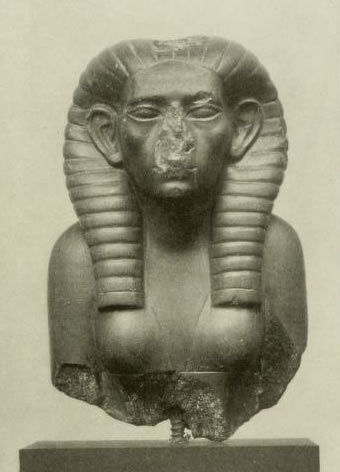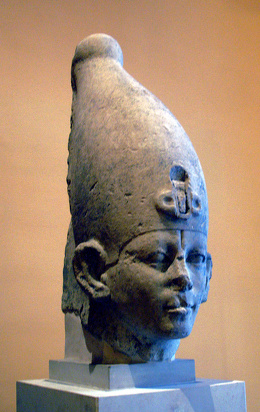Home | Category: Old and Middle Kingdom (Age of the Pyramids)
MIDDLE KINGDOM RULERS

Turin King List 7
The Middle Kingdom began with the reunion of Egypt under Mentuhotep II. Earlier rulers in the 11th dynasty, which was centered in Thebes, had begun to reassert their authority over fragmented Egypt but Mentuhotep II was the first to unify the kingdom. The Middle Kingdom pharaohs ruled for 250 years. Over time squabbling and turmoil weakened the kingdom and allowed it be conquered by the Hyksos. The Hyksos and the forces from the city of Thebes fought naval battles in the Nile.
According to Minnesota State University, Mankato: The Middle Kingdom is considered to have started with Nebhepetre Mentuhotep I uniting all of Egypt. He ruled for 51 years and his reign brought much stability to Egypt. His conquest of much of Egypt meant draining the nonarchs of their armies and subsequently their power. This put Nebhepetre Mentuhotep I in such a position as king that had not been realized since Phiops II. His son ruled for some time but eventually Amenemhet I overthrew his grandson, Mentuhotep IV, marking the end of the 11th Dynasty. This apparently required assistance from the nomarchs. Some nomarchs would continue to hold king-like powers until Senusret III stripped them of it. [Source: Minnesota State University, Mankato, ethanholman.com +]
Wolfram Grajetzki of University College London wrote: “The kings of the 12th Dynasty are well known from many contemporary sources. The length of their reigns is partly preserved in the Ramesside king list known as the Turin Canon and are also known from Manetho, although there are problems in the details of these numbers. In recent Egyptological literature there has been some debate over whether 12th Dynasty kings cemented the succession from one reign to another with coregencies. The absolute dates of the reigns rely heavily on astronomical data in temple documents found at el-Lahun, particularly one papyrus, which mentions the rising of Sothis in year 7 of Senusret III. However, there is no consensus yet on how to interpret the data. [Source: Wolfram Grajetzki, University College London, UCLA Encyclopedia of Egyptology, 2013 escholarship.org ]
“The names of the 13th Dynasty kings are omitted from the Ramesside king lists at Abydos and Saqqara and the copies of Manetho’s work. The only preserved king list for the dynasty is the Turin Canon, but this is incomplete. The order in the papyrus seems essentially correct, although the placement of single kings is debatable, and most year dates are lost. The length of the whole 13th Dynasty is only preserved in Manetho, who gives 453 years. It is generally agreed that this number might be a mistake and should be 153 years.”
RELATED ARTICLES:
MIDDLE KINGDOM OF ANCIENT EGYPT (2030–1640 B.C.): ACHIEVEMENTS, CHALLENGES, CULTURE africame.factsanddetails.com ;
DYNASTIES OF THE MIDDLE KINGDOM OF ANCIENT EGYPT (2030–1640 B.C.)
africame.factsanddetails.com
Websites on Ancient Egypt: UCLA Encyclopedia of Egyptology, escholarship.org ; Internet Ancient History Sourcebook: Egypt sourcebooks.fordham.edu ; Discovering Egypt discoveringegypt.com; BBC History: Egyptians bbc.co.uk/history/ancient/egyptians ; Ancient History Encyclopedia on Egypt ancient.eu/egypt; Digital Egypt for Universities. Scholarly treatment with broad coverage and cross references (internal and external). Artifacts used extensively to illustrate topics. ucl.ac.uk/museums-static/digitalegypt ; British Museum: Ancient Egypt ancientegypt.co.uk; Egypt’s Golden Empire pbs.org/empires/egypt; Metropolitan Museum of Art www.metmuseum.org ; Oriental Institute Ancient Egypt (Egypt and Sudan) Projects ; Egyptian Antiquities at the Louvre in Paris louvre.fr/en/departments/egyptian-antiquities; KMT: A Modern Journal of Ancient Egypt kmtjournal.com; Egypt Exploration Society ees.ac.uk ; Amarna Project amarnaproject.com; Abzu: Guide to Resources for the Study of the Ancient Near East etana.org; Egyptology Resources fitzmuseum.cam.ac.uk
RECOMMENDED BOOKS:
“Ancient Egypt Transformed: The Middle Kingdom" edited by Adela Oppenheim, Dorothea Arnold, Dieter Arnold, et al. (2015) Amazon.com;
"The Middle Kingdom of Ancient Egypt: History, Archaeology and Society" by Wolfram Grajetzki, Amazon.com;
“Analyzing Collapse: The Rise and Fall of the Old Kingdom” by Miroslav Bárta , Aidan Dodson, et al. (2020) Amazon.com;
“Life and Afterlife in Ancient Egypt during the Middle Kingdom and Second Intermediate Period” by Silke Grallert and Wolfram Grajetzki (2007) Amazon.com;
“Death, Power, and Apotheosis in Ancient Egypt: The Old and Middle Kingdoms”
by Julia Troche (2021) Amazon.com;
“Labour Organisation in Middle Kingdom Egypt, Illustrated, by Micòl Di Teodoro (2018) Amazon.com;
“Rise of the Hyksos: Egypt and the Levant from the Middle Kingdom to the Early Second Intermediate Period” by Anna-Latifa Mourad (2015) Amazon.com;
“Hyksos: A Captivating Guide” Amazon.com;
“The Hyksos: A New Investigation” by John Van Seters (2010) Amazon.com;
Hyksos and Israelite Cites (Classic Archaeological Reprints)
by W. M. Flinders Petrie; J. Garrow Duncan Amazon.com;
The Oxford History of the Ancient Near East: Volume III: From the Hyksos to the Late Second Millennium BC” by Karen Radner, Nadine Moeller, et al. (2022) Amazon.com;
List of Middle Kingdom Rulers
Middle Kingdom Rulers
ca. 2030–1640 B.C.
Dynasty 11, second half, ca. 2030–1981 B.C.
Mentuhotep II (cont.): ca. 2030–2000 B.C.
Mentuhotep III: ca. 2000–1988 B.C.
Qakare Intef: ca. 1985 B.C.
Sekhentibre: ca. 1985 B.C.
Menekhkare: ca. 1985 B.C.
Mentuhotep IV: ca. 1988–1981 B.C.
[Source: Department of Egyptian Art, The Metropolitan Museum of Art, October 2002]
Dynasty 12, ca. 1981–1802 B.C.
Senusret I: ca. 1961–1917 B.C.
Amenemhat II: ca. 1919–1885 B.C.
Senusret II: ca. 1887–1878 B.C.
Senusret III: ca. 1878–1840 B.C.
Amenemhat III: ca. 1859–1813 B.C.
Amenemhat IV: ca. 1814–1805 B.C.
Dynasty 13, ca. 1802–1640 B.C.
Mentuhotep II
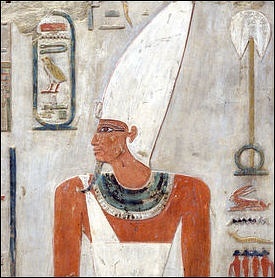
Mentuhotep II
The Middle Kingdom began with the reunion of Egypt under Mentuhotep II. Earlier rulers in the 11th dynasty, which was centered in Thebes, had begun to reassert their authority over fragmented Egypt but Mentuhotep II was the first to unify the kingdom. Mentuhotep II was from Upper Egypt. His conquest of Lower Egypt took time as reflected by gradual changes in his title from "One Who Gives Heart to Two Lands" to "Lord of White Crown (Upper Egypt)" to "Unifier of the Two Lands." Mentuhotep II's 50-year reign ushered in a rebirth of Egyptian culture.
Mentuhotep II was also known as Nebhepetre Mentuhotep I He ruled for 51 years in the 10th and 11th Dynasties. His reign brought stability to Egypt, and his conquests robbed local warlords of their armies and subsequently their power. This put Nebhepetre Mentuhotep I in an unrivaled position as king not been realized since Phiops II. Mentuhotep II’s son, Mentuhotep III, succeeded him. [Source: Minnesota State University, Mankato, ethanholman.com +]
Nebhetepre Mentuhotep I ruled united Egypt for about 39 years during the 11th Dynasty. The change from his first name 'One Who Fives Heart to Two Lands' to 'Lord of the White Crown’ (Upper Egypt) clearly marks his transition from being a regional ruler to the ruler of Upper Egypt. The name 'Uniter of the Two Lands’ obviously marks the point at which Mentuhotep reunited all of Egypt. +\
Upon defeating the Herakleopolitans and reuniting Egypt, peace and prosperity settled over Egypt. This marked the beginning of the Middle Kingdom with Mentuhotep as being the first king. Mentuhotep began several building projects at different sites. Of the works that were built none is marveled more than the mortuary complex at Deir el-Bahari. This magnificent complex was built into the cliffs on the west bank of the Nile. It inspired the famous temple of Hatshepsut built nearby 500 years later. +\
Amenemhet I and II
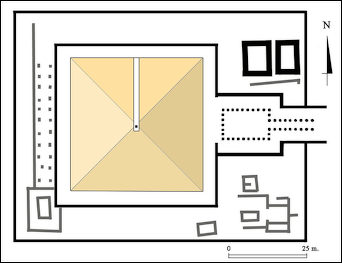
Pyramid of Amenemhet I
According to Minnesota State University, Mankato:“Amenemhet (also known as Amenemmes I, Amenemhat I), was a vizier to Mentuhotep III. After returning from an expedition to retrieve a stone lid for the king's sarcophagus, Amenemhet dethroned Mentuhotep III. Amenemhet I, then became king and ruled Egypt for the next 30 years. He was the first king of the 12th Dynasty. [Source: Minnesota State University, Mankato, ethanholman.com +]
“During the early part of his reign he traveled up the Nile crushing recalcitrant nomarchs, Asiatics and Nubians. He also set up a new capital at Itj-tawy, Seizer-of-the-Two-Lands. The king took the additional title of Wehem-meswet, Repeater-of-Births. In the twentieth year of his reign he proclaimed his son Senusret a joint king of Egypt. This began a tradition of co-regency to the Egyptian throne. The royal burial ground was moved during the reign of Amenemhet I, to Lisht, at the entrance to the Faiyum. Amenemhet I's, pyramid resembled those of the Old Kingdom-just smaller. +\
“After succeeding his father, Senusret I, Amenemhet II (Amenemmes II, Amenemhat II) ruled for 34 years. During his long reign the Egyptians made more use of the Faiyum. It was utilized for hunting, fishing and cultivating. The Faiyum made the irrigation system that was well known, but made it much more effective and so the Bahr Yusuf canal was widened and deepened. Amenemhet II continued the foreign policy of his predecessors and carried on peaceful relations with Near East powers. There are signs of gifts being passed back and forth between them. There are also signs of extensive trading operations in the Near East and Crete as well. Amenemhet II's son, Senusret, became co-regent with him during the last three years of his reign. He built his pyramid in Dahshur, to the east of the 4th Dynasty pyramids. +\
Senusret I and II

Senusret I
According to Minnesota State University, Mankato: Senusret I (also known as Sesostris I, Senwosret I) “served as co-regent with his father until his father's death at which time he became the second king of the 12th Dynasty. Senusret I ruled for 34 years following his father's death. Senusret I took his son, Amenemhet II, as co-regent for the last three years of his reign. His pyramid complex was built at Lisht, about 1 mile south of his father's pyramid. [Source: Minnesota State University, Mankato, ethanholman.com +]
“During his reign, a series of 13 forts were built down to the Second Cataract. Gold mines near Coptos and agricultural goods from the Wadi Hammamat were utilized. Quarries and mines were also exploited throughout Egypt. During his long reign Senusret I led various expeditions to the south and to the oases. He carried out building projects at over three dozen sites around Egypt.” +\
Senusret II (Sesostris II, Senwosret II) “began as co-regent with his father, Amenemhet II. His reign was marked by a long period of peace. He continued the foreign policies of his predecessors and was also popular with the provincial elites. He continued the cultivation efforts in the Faiyum. Senusret II built his pyramid at Luhan. +\
Senusret III
Senusret III (1878 B.C. to 1841 B.C.) was the greatest of the warrior pharaohs. He consolidated power by restructuring the government and established a series of forts that were within signaling distance of one another. He was the 5th King of the 12th Dynasty and ruled for 37 years following his father's death. It does not appear that Senusret III's father, Senusret II, named him co-ruler during his father's rule as was the case with many earlier rulers. +\
Dieter Arnold of the Metropolitan Museum of Art wrote : “King Senusret III (r. 1878–1840 B.C.) was one of the most powerful and important rulers of ancient Egypt. Key developments in religion, political administration, and the arts took place during his reign. He built two funerary complexes, one in Abydos and the other at the north end of the Dahshur pyramid field. [Source: Arnold, Dieter. The Metropolitan Museum of Art, October 2004, metmuseum.org \^/]
According to Minnesota State University, Mankato: Senusret III is believed to have stood about 6"6' which for some reason is believed to have been important in his internal changes in the government. This mainly consisted of subjugating the nomarchs who had gained too much power and threatened the monarchy. He also appointed three officials to oversee select parts of Egypt.” [Source: Minnesota State University, Mankato, ethanholman.com +]
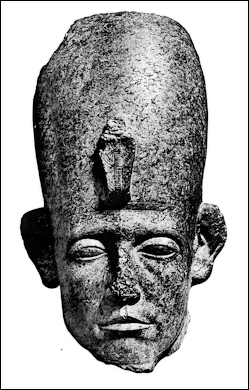
Senusret III
Senusret III (Sesostris III, Senwosret III) “led several campaigns to Nubia and one to Syria. The Nubian expeditions were aimed at subjugating Lower Nubia and making it safer for trade. Two campaigns were directly in response to rebellions. The one expedition to Syria is believed to have been only to plunder the area and as a way to demoralize the people of that region. On one of his expeditions, Senusret III left an admonition for his future forbears; it was a statement that the boundary set by him was to be maintained if an heir was to be related to him, otherwise the king was not related to him. This might explain why Senusret III was later worshipped as a god in Nubia. +\
“Although known for his military prowess, Senusret III was also known as a builder. One of his projects was a temple built in honor of the war god Montu. He built the largest pyramid of the 12th Dynasty at Dahshur, but not much of it survived to the present.” Arnold wrote: Unlike Old Kingdom pyramids, which were constructed entirely of stone, Senusret III's pyramid had a mud-brick core cased with limestone. In ancient times, the valuable limestone was removed by robbers, revealing the soft brick core. As a result of long exposure, the pyramid has now deteriorated to a 21-meter-high mound with a deep crater in the center; originally the pyramid was 62 meters high.” \^/+\
Wolfram Grajetzki of University College London wrote: “King Senusret III seems to have reigned alone for 19 years and perhaps had a further coregency with his son Amenemhat III for about 20 years, although this is far from certain. He is mainly known for his military campaigns in Lower Nubia. Enterprises in South Palestine are less well known; the evidence includes the biographical texts of Sobekkhu on his Abydos stela and of the “high steward” and vizier Khnumhotep in his mastaba at Dahshur. Close contacts are attested to Byblos for the 12th but also for the 13th Dynasty. Lower Nubia was placed under permanent Egyptian control, and a chain of fortresses was (re)built, most of which have been excavated. Nothing similar has so far been attested for Palestine, and the character of Egyptian rule there remains enigmatic. Senusret III built a pyramid at Dahshur, but also a vast funerary complex at Abydos. Perhaps the king was even buried there. From Abydos also comes the biographical inscription of the “treasurer” Ikhernofret, in office under this king. He reports the arrangement of processions and festivals at Abydos. [Source: Wolfram Grajetzki, University College London, UCLA Encyclopedia of Egyptology, 2013 escholarship.org ]
Pyramids of the Queens and Princesses of Senusret III
Adela Oppenheim of the Metropolitan Museum of Art wrote: “Flanking the pyramid of Senusret III on the north and south were seven smaller pyramids that primarily belonged to women of the royal family. Beginning with the Dynasty 4 pharaoh Khufu (r. 2551–2528 B.C.), small pyramids for queens and princesses were commonly placed near the pyramid of the king. [Source: Adela Oppenheim, Department of Egyptian Art, The Metropolitan Museum of Art, October 2004, metmuseum.org\^/]
“The three pyramids to the south of Senusret III's pyramid are earlier and larger than those to the north. The easternmost pyramid of this group probably did not belong to a royal woman, but rather was intended to house the ka, a part of the king's spirit that played an important role in his afterlife. The center pyramid on the south belonged to a Queen Weret I. Inscriptions found around her pyramid, and also at other monuments in Egypt, tell us that she was the mother of a king, presumably Senusret III. No burial chamber was discovered under or near Queen Weret I's pyramid, leading to the conclusion that she was interred elsewhere, perhaps at Lahun near the Faiyum oasis with her presumed husband Senusret II. In this case, Queen Weret I's pyramid at Dahshur would have served as a cenotaph or memorial. The queen mother seems to have played an important role in the king's afterlife. \^/
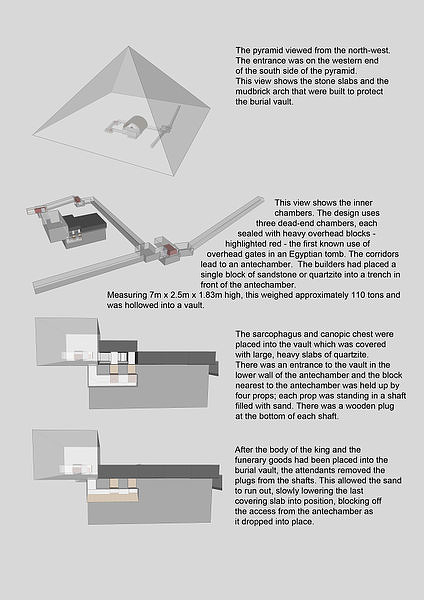
Amenemhat III's Pyramid
“The westernmost pyramid on the south side belonged to Queen Weret II, the principal wife of Senusret III. Although her tomb was plundered in antiquity, its entrance remained hidden under the desert sands for centuries until the entrance shaft was found by the Metropolitan Museum excavation in 1994. Queen Weret II's elaborate underground burial complex consists of a shrinelike construction placed under her pyramid and elaborate burial chambers that were actually built beneath the pyramid of the king; the two spaces are connected by a long corridor. Several small objects and pottery that escaped the attention of the tomb robbers were found in her burial chambers. Most surprising was the rare discovery of a cache of the queen's jewelry in a niche at the bottom of the entrance shaft; the unusual placement of the deposit probably led to its being overlooked by the tomb robbers. The objects include two amethyst scarabs inscribed for the pharaoh Amenemhat II, two bracelets with djed-pillar clasps signifying stability, two bracelets with gold lion pendants, a girdle composed of gold cowrie shells, and two anklets with claw pendants. The pieces, now on display in the Egyptian Museum, Cairo, represent the sixth major find of royal Middle Kingdom jewelry. On display in the Metropolitan Museum is another jewelry collection that belonged to the Dynasty 12 princess Sit-Hathor-yunet; this group of objects was excavated by the British at Lahun. \^/
“North of Senusret III's pyramid are four smaller pyramids, built later in the king's reign. The second and third from the east belonged respectively to Princess Itakayet and Queen Nefrethenut; the owners of the other two pyramids remain unknown. Burial chambers with stone sarcophagi were placed beneath each of the four pyramids. To the east of the easternmost pyramid, eight royal women were buried in small chambers hollowed out on either side of a common corridor. In this area, Jacques de Morgan (1857–1924) discovered two caches of jewelry on two successive days in 1894. Both treasures are now displayed in the Egyptian Museum, Cairo. \^/
“All of the pyramids belonging to royal women had small chapels dedicated to the cult of the deceased; the four north pyramids seem to have had only east chapels, while the two queens' pyramids on the south had north and east chapels. Fragments of relief decoration recovered from these structures indicate that the decorative program consisted mainly of standard offering scenes: processions of offering bearers carrying food approached the queen or princess, who was seated in front of a table. In front of the woman was a large list enumerating the type and quantity of goods she could expect to receive in the afterlife. Additional spaces were filled with representations of piled foodstuffs. The area around the door included scenes of men butchering cattle for meat offerings. Inscriptions above the figures of the women, at the tops of the walls, and above the entrance listed their names and titles.” \^/
Statues of Senusret III and Amenemhat III
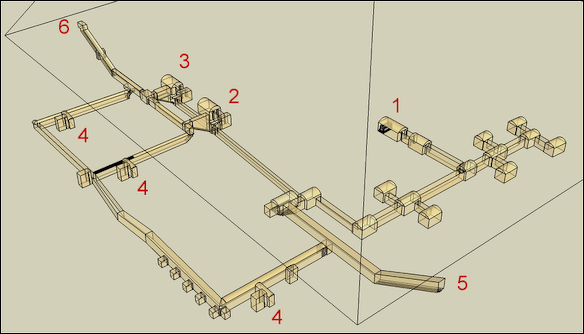
Amenemhet III's pyramid sunstructure
Dimitri, Laboury of the University of Liège in Belgium wrote: “Senusret III and Amenemhat III. The statuary of Senusret III and his son and direct successor Amenemhat III is one of the most central issues in the debate about portraiture in ancient Egyptian art. Since the nineteenth century, the extraordinary individualization that seems to characterize their statues impressed beholders and induced the well- established conviction that the ancient Egyptian sculptors of the late 12th Dynasty intended to portray these two kings in a hyperrealistic manner. This interpretation legitimated psychological readings of these effigies, which were thought to express the royal lassitude after a long wearying reign or even kingly sorrow. According to this widely accepted hypothesis, the stylistic variability attested in Senusret III’s and Amenemhat III’s portraits—as in the iconography of any other pharaoh—could be explained by the ageing of the kings, translated step by step into sculptures, and by the local traditions of sculptor’s workshops, which again is a long- lived assumption in ancient Egyptian art history that has never been convincingly demonstrated. [Source: Dimitri, Laboury, University of Liège, Belgium, UCLA Encyclopedia of Egyptology 2010, escholarship.org ]
“This traditional interpretation is highly questionable. Even without mentioning its striking incompatibility with what we know about the historical personalities of Senusret III and Amenemhat III, probably two of the strongest kings who ever ruled Egypt, such a culturally induced reasoning can be invalidated by pure art historical evidence. As Roland Tefnin underlined, the unmistakable contrast between a supposedly old face and a perfectly firm, young, and powerful body is difficult to explain, especially for a hyperrealistic representation. In her thorough analysis of the entire corpus of the statuary of Senusret III and his son, Felicitas Polz was able to demonstrate that the latest datable statues of Amenemhat III—namely those from his mortuary complex at Hawara and from the small temple at Medinet Madi, which was completed by his successor—show the least aged physiognomy, as if the king were getting younger with the passing of time. Although not a single typological or physiognomic peculiarity can be exclusively linked to a specific site or region, both kings’ statues from one and the same series display stylistic variations in the reproduction of the king’s facial model, just like Menkaura’s triads. Furthermore, the emancipation from the traditional hieroglyphic abstraction and the very marked physiognomy that truly characterize Senusret III’s and Amenemhat III’s portraiture actually appeared one generation earlier in private statuary, which, at least this time, influenced royal art.
“Even if one acknowledges Junge’s idea of a “borrowed personality”—a concept that, once again, blurs the theoretical opposition between portrait and ideal image—the effigies of Senusret III and Amenemhat III cannot be considered the expression of “a love of realism,” which, to quote J. Vandier, would have justified “that new official portraits were executed every time the king physically changed, in a sense that could only be unpleasant for the ruler’s self-esteem”. They obviously convey a message about the nature of kingship as it was conceived at that time— in keeping with an important contemporary textual production on the same subject (cf. the royal hymns on both royal and private monuments and the corpus of literature studied by G. Posener in his famous book “Littérature et politique”)—notably through the use of some reality effects, which were able to suggest special qualities relating to the mouth, eyes, and ears, but have nothing to do with the modern western concept of hyperrealism. In this context, without the mummies of these two kings, it is impossible to evaluate the plausible resemblance between pharaoh’s real face and his sculptured portraits. However, a physiognomic convergence seems rather likely—simply because the same stylistic formula was actualized differently for Senusret and for Amenemhat. [Source: Dimitri, Laboury, University of Liège, Belgium, UCLA Encyclopedia of Egyptology 2010, escholarship.org ]
Amenemhat III and the End of the 12th Dynasty
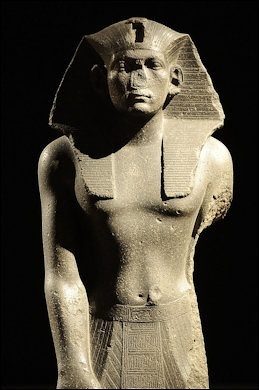
Praying statue of Amenemhat III
According to Minnesota State University, Mankato: “After a brief period of co-regency Amenemhet III (Amenemmes III, Amenemhat III), the son of Senusret III, ruled for about 45 years. He was the 6th king of the 12th Dynasty. Like his predecessors he continued the expansion of cultivation in the Faiyum and was an avid builder. There is no record of any military actions during his reign and the general prosperity of this time would support that. Amenemhet III had two large pyramid's built that were almost as large as his father's pyramid. The first was built at Dahshur but was not used and the second was built at Hawara. Hawara is were Amenemhet III and his daughter were laid to rest. The building project of note by Amenemhet III was the temple built at Kiman Faris in honor of the crocodile god Sobek. In 1822 B.C. Amenemhet III built a labyrinthine funerary temple with 3,000 rooms and a multitude of pillars. [Source: Minnesota State University, Mankato, ethanholman.com +]
Wolfram Grajetzki of University College London wrote: “Amenemhat III reigned for about 45 years (1868 - 1822 B.C.). He is mainly known for his building activities, while few military campaigns have been attested during his rule so far. He built two pyramids. The one at Dahshur, erected during the first part of his reign, was abandoned as king’s tomb because of technical problems. Instead it was used as burial ground for his closest female kin. The second pyramid was built during the second part of his reign at Hawara, at the entrance to the Fayum, where there is some further evidence for royal buildings. The underground burial chamber of the pyramid at Hawara was smaller than the earlier Middle Kingdom pyramids, but were equipped with elaborate security systems. Art and craft production went on without a break, so that it is often impossible to determine whether an object belongs to one or the other dynasty. Some of the finest works of Middle Kingdom private sculpture were made during the 13th Dynasty. The royal residence was still at Itytawy. [Source: Wolfram Grajetzki, University College London, UCLA Encyclopedia of Egyptology, 2013 escholarship.org ]
“The last two rulers of the 12th Dynasty were Amenemhat IV (1822 - 1812 B.C.); Grajetzki 2006: 61) and the ruling queen Neferusobek, perhaps a son and a daughter of Amenemhat III. Amenemhat IV reigned nine and Neferusobek three years, 10 months, and 24 days (according to the Turin Canon). Amenemhat IV is still well attested within Egypt, although big building projects are missing, which might relate to his short reign. Neferusobek (1812-1809 B.C.) appears in some inscriptions in the funerary complex of Amenemhat III at Hawara and is known from some additional objects. The end of the 12th Dynasty and the succession to the 13th Dynasty are still not fully understood. It is most often assumed that Amenemhat IV did not leave any male heir and that Neferusobek also died without an heir so that a new, unrelated line of rulers ascended the throne.”
Neferusobek — Egypt's First Female Pharaoh?
During ancient Egypt’s roughly 3,000-year history, only six women — Merneith, Neferusobek, Hatshepsut, Nefertiti, Tawosret, and Cleopatra — ruled. Of these, Neferusobek (Sobekneferu) was the first woman to take the Egyptian kingship as her formal title. The product of the royal harem and nursery during the 12th dynasty (1939–1760 B.C.), she was the daughter of one of hundreds of women who sexually served King Amenemhat III. Kara Cooney wrote in National Geographic: The royal princess understood that in order to maintain the familial lineage she would one day marry her aged father, or, when he died, she would be linked to her brother, the next king, as a great royal wife of the highest bloodline. (In fact, Neferusobek’s mother may have been the king’s daughter, too, though there is no record of it.) Even though it started out that way, this was not to be her fate. [Source: Kara Cooney, adapted from “When Women Ruled the World”, National Geographc Partners, October 30, 2018]
Upon his death, King Amenemhat III son, Amenemhat IV, assumed the throne and as planned, Neferusobek became his wife. For Egyptian nobility, this news was greeted with a great sigh of relief, knowing that their status quo would be upheld, for another few decades at least, and that new heirs would soon enter the royal line. Neferusobek was now queen, and a king’s daughter to boot. After just nine years of rule, however, Amenemhat IV died, having produced no viable heirs.
All the courtiers looked to the royal family to solve the situation: to maintain the balance of power among the elites, to keep the wealth pouring in. The 12th dynasty found itself in a succession crisis of the highest order. As the highest-ranked family member left, Neferusobek stepped forward as nothing less than king, using her descent from the great King Amenemhat III to justify her rule. For the first time in human history, a royal Egyptian woman claimed the highest office in the land — the kingship itself — for the simple reason that there was no royal man to take it.
To uphold her father’s dynasty and further legitimize her kingship, Neferusobek ordered the completion of her father’s pyramid complex at Hawara. She also took an unprecedented step and ordered her father deified within his temple spaces. Although all kings were considered divine, and all dead kings had a greater divinity among the company of ancestor kings, Neferusobek went a step further and created special cult spaces for the worship of her father as a god at his temple at Hawara. She set aside extensive lands whose income of grain and flax and livestock would support an ongoing cult, paying priests an annual salary to regularly make offerings to the statues of the dead king.
Short Rule of Neferusobek
Kara Cooney wrote in National Geographic: When Neferusobek ascended the throne, she went through weeks of temple activities, initiations, meditations, and ceremonies that invested her with the divine power of sovereignty (which Egyptians agree she had possessed since the time of her birth). It was also determined that “queen” was not the proper title for her; queens were subservient to their sovereign. As such, she received five royal names, including (S)he of the Sedge Plant and the Bee, Mistress of the Two Lands, and Daughter of Re — kingly titles that were feminized specifically for her in Egyptian hieroglyphics. She was king, period.
As soon as she became king, Neferusobek immediately got to work protecting the family dynasty. She had her images placed in temples all around Egypt; three statues were found at the eastern delta’s Tell el Dab’a in association with 12th dynasty temple installations. Frustratingly, none of her named statues preserve her face. One of these statues sits in the Louvre today. Headless, unfortunately, it depicts her wearing the Nemes headdress falling over her shoulders, the very same striped headcloth that Tutankhamun would wear much later in his golden funerary mask. She is wearing a queen’s dress, but she has tied on the kilt of kingship over her feminine garb, knotted much higher than a masculine king’s kilt would have been: above her navel and just below her breasts. Around her neck she wears the same pierced heart amulet her grandfather and her father wore, a sign of 12th dynasty strength and of her direct linear descent from those great kings. She did not lie to her people or to her gods about her gender; her femininity was there for all to see. And yet she layered the masculinity of her new office over her feminine self.
During Neferusobek’s third year as king, the Nile River experienced a drought, sending Egypt to the brink of disaster as crops failed and famine struck. No doubt she tapped her rich grain stores, opening state-controlled bins to feed hungry Egyptians by using the great wealth amassed from years of plenty. Meanwhile, everyone likely talked and schemed about the fact that Neferusobek was the last of her family — and that a change in dynasty was soon to come. And then it happened, much sooner than expected. After only three years, 10 months, and 24 days, according to the Turin king list, Neferusobek’s reign came to an abrupt conclusion. With her death came the end of one of Egypt’s greatest ruling families.
How Neferusobek died remains an open question. Some Egyptologists have postulated that she met an untimely end, murdered for taking the kingship that didn’t rightfully belong to a woman. But the fact that she took the sovereignty and ruled unopposed for years suggests otherwise. And the Egyptians, in their way, thanked Neferusobek for what she had done for them: She was preserved in most of the king lists. She wasn’t considered heretical or undeserving because of her sex. She protected her land in a time of distress, and for that she was honored.
Succession and Origin of Kings in the 13th Dynasty
Wolfram Grajetzki of University College London wrote: “The 13th Dynasty (1809 - 1656 B.C.) consisted of a line of about 50 kings ruling for a total of c. 150 years. The names of the first 31 rulers of the dynasty are preserved in the Turin Canon. Although there are some problems with the details, the general order of the king list seems to be correct and provides a rough guideline. However, the lengths of the reigns are most often destroyed in the papyrus. The names of the following kings are lost for the most part. [Source: Wolfram Grajetzki, University College London, UCLA Encyclopedia of Egyptology, 2013 escholarship.org ]
“A number of rulers only known from archaeological attestations seem to belong to this dynasty, and, although their exact placement within the dynasty often is highly speculative, the majority may have ruled towards the end of the dynasty. It remains unknown why so many kings ruled during such a relatively short period, and all suggestions are pure speculation. The kings of the dynasty are not a line of rulers connected by family ties. The term dynasty, used by Manetho, evidently refers to a group of kings belonging to the same period, perhaps with the same capital. Nevertheless, some family connections within the dynasty are visible. The kings Neferhotep I, Sahathor, and Sobekhotep IV were brothers and ruled together for about 20 years. Another, although indirect, attestation for kings connected by family ties is Nubhetepi, who is titled both the “king’s wife” and the “king’s mother.” Her name is not yet linked to any particular kings’ names although several possibilities have been proposed.
“A number of kings, especially of the early 13th Dynasty, have a double- and one even a triple-name: Amenemhat Antef Ameny . Especially Spalinger have argued that these names represent filiations: “X’s (son) Y.” However, the evidence for this type of filiation is not conclusive and others have argued against it because giving double- names was a common practice in the late khendjer, meaning “boar,” is foreign, it was incorporated in the Egyptian language.
“A new feature is the mentioning of non- royal parents in royal inscriptions for several kings of the middle of the dynasty. On monuments and scarabs, Sobekhotep III refers to his non-royal parents Mentuhotep and Iuhetibu. The brothers Neferhotep I and Sobekhotep IV refer to their father Haankhef and mother Kemi.”
First Kings of the 13th Dynasty
Wolfram Grajetzki of University College London wrote: “ There is some confusion about the first king of the 13th Dynasty. For some kings there is evidence that they were high state officials before becoming king. King Wegaf was perhaps “great overseer of troops” before ascending the throne, an official with that rare name is known from a scarab seal. King Sekhemra-sewadjtawi Sobekhotep III is perhaps identical with a “commander of the ruler’s crew” known from about 15 scarab seals. Family ties to leading officials are visible via the queens of the dynasty. Queen Aye, mentioned in Papyrus Boulaq 18, was related to the family of the vizier Ankhu; Nubkhaes came from a family of leading officials. The name of King Mermesha translates as “overseer of troops.” His name was often taken as an example of a military leader coming to power. However, Mermesha is also attested as a proper name. Therefore the evidence does not seem conclusive. [Source: Wolfram Grajetzki, University College London, UCLA Encyclopedia of Egyptology, 2013 escholarship.org ]
“It has often been claimed that also foreign usurpers ascended the throne, but the evidence is vague. King Khendjer has perhaps a foreign name, but even though the word Khutawyra is named. This is the throne name of King Wegaf known from contemporary monuments. However, there is also King Khutawy- Sekhemra Sobekhotep, appearing as 19th king of the dynasty in the Turin Canon. This king is known from rock inscriptions in Lower Nubia recording the highest Nile level of certain years, and he is mentioned in the Lahun papyri. In both types of documents, mainly kings of the late 12th and early 13th Dynasties appear, but no rulers of the advanced 13th Dynasty. For that reason it has been assumed that the copyist of the papyri confused King Khutawyra with Khutawy-Sekhemra, both with a similar throne name. However, other Egyptologists do not follow this assumption; without further evidence, the question of the first king of the 13th Dynasty remains open. The following rulers of the 13th Dynasty were a large number of kings with brief reigns. They are not known from many contemporary monuments, although King Ameny Qemau and King Auibra Hor are attested by their tombs. It is possible that many of them just ruled for a short time, perhaps even less than one year, and several are only known from the Turin Canon.”
Image Sources: Wikimedia Commons
Text Sources: UCLA Encyclopedia of Egyptology, escholarship.org ; Internet Ancient History Sourcebook: Egypt sourcebooks.fordham.edu ; Tour Egypt, Minnesota State University, Mankato, ethanholman.com; Mark Millmore, discoveringegypt.com discoveringegypt.com; Metropolitan Museum of Art, National Geographic, Smithsonian magazine, New York Times, Washington Post, Los Angeles Times, Discover magazine, Times of London, Natural History magazine, Archaeology magazine, The New Yorker, BBC, Encyclopædia Britannica, Time, Newsweek, Wikipedia, Reuters, Associated Press, The Guardian, AFP, Lonely Planet Guides, “World Religions” edited by Geoffrey Parrinder (Facts on File Publications, New York); “History of Warfare” by John Keegan (Vintage Books); “History of Art” by H.W. Janson Prentice Hall, Englewood Cliffs, N.J.), Compton’s Encyclopedia and various books and other publications.
Last updated July 2024

